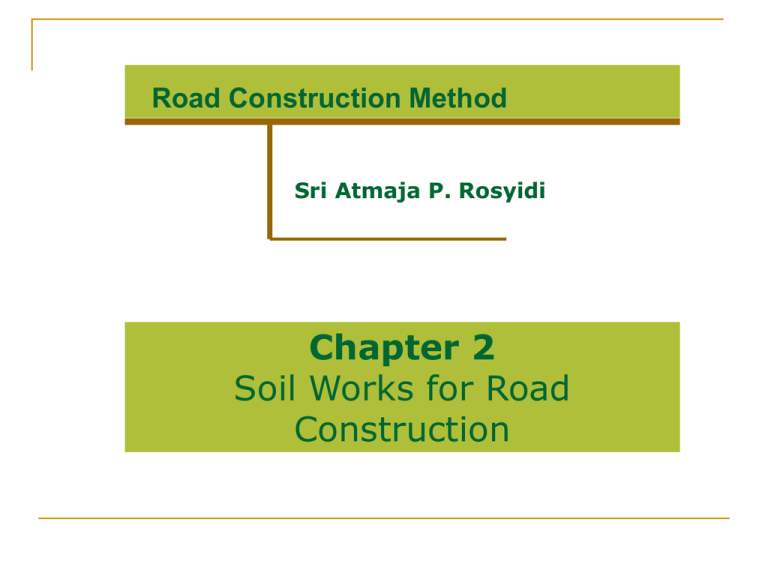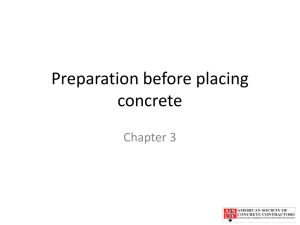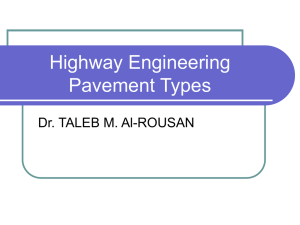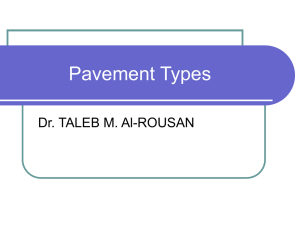Road Construction Method
advertisement

Road Construction Method Sri Atmaja P. Rosyidi Chapter 2 Soil Works for Road Construction Subgrade Layer in Pavement Profile Although a pavement's wearing course is most prominent, the success or failure of a pavement is more often than not dependent upon the underlying subgrade - the material upon which the pavement structure is built. Subgrades be composed of a wide range of materials although some are much better than others. This subsection discusses a few of the aspects of subgrade materials that make them either desirable or undesirable and the typical tests used to characterize subgrades. A subgrade’s performance generally depends on three of its basic characteristics (all of which are interrelated): 1. Load bearing capacity. The subgrade must be able to support loads transmitted from the pavement structure. This load bearing capacity is often affected by degree of compaction, moisture content, and soil type. A subgrade that can support a high amount of loading without excessive deformation is considered good. 2. Moisture content. Moisture tends to affect a number of subgrade properties including load bearing capacity, shrinkage and swelling. Moisture content can be influenced by a number of things such as drainage, groundwater table elevation, infiltration, or pavement porosity (which can be assisted by cracks in the pavement). Generally, excessively wet subgrades will deform excessively under load. 3. Shrinkage and/or swelling. Some soils shrink or swell depending upon their moisture content. Additionally, soils with excessive fines content may be susceptible to frost heave in northern climates. Shrinkage, swelling and frost heave will tend to deform and crack any pavement type constructed over them. Poor Subgrade Poor subgrade should be avoided if possible, but when it is necessary to build over weak soils there are several methods available to improve subgrade performance: 1. Removal and replacement (over-excavation). Poor subgrade soil can simply be removed and replaced with high quality fill. Although this is simple in concept, it can be expensive. Table in right shows typical over-excavation depths recommended by the Colorado Asphalt Pavement Association (CAPA). 2. Stabilization with a cementitious or asphaltic binder. The addition of an appropriate binder (such as lime, portland cement or emulsified asphalt) can increase subgrade stiffness and/or reduce swelling tendencies. 3. Additional base layers. Marginally poor subgrade soils may be compensated for by using additional base layers. These layers (usually of crushed stone – either stabilized or unstabilized) serve to spread pavement loads over a larger subgrade area. This option is rather perilous; when designing pavements for poor subgrades the temptation may be to just design a thicker section with more base material because the thicker section will satisfy most design equations. However, these equations are at least in part empirical and were usually not intended to be used in extreme cases. In short, a thick pavement structure over a poor subgrade will not necessarily make a good pavement. Brief of Common Soil Properties Used in Pavement Construction 1. Site Investigation 2. Construction Works ROAD CONSTRUCTION SOIL WORKS SUB-BASE WORKS 1. Specification 2. Material Selection 3. Construction Works BASE WORKS SURFACE WORKS Brief of Common Soil Properties Used in Pavement Construction 1. Topography Investigation 1 SOIL INVESTIGATION 2. Geology Investigation 3. Laboratory Investigation 4. Field Investigation 5. Subgrade Design SOIL WORKS REPORT 1. Landscape Works 2. Stripping Works 2 CONSTRUCTION WORKS 3. Compaction Works 4. Stabilization Works 5. Others Geological Terms SOIL INVESTIGATION Principles of Soil Properties Weight-volume relationships © 2004 Brooks/Cole Publishing / Thomson Learning™ 1. Grain-size distribution curve obtained from sieve analysis © 2004 Brooks/Cole Publishing / Thomson Learning™ 2. Grain-size distribution curve obtained from hydrometer analysis for fine material (clay & silt) © 2004 Brooks/Cole Publishing / Thomson Learning™ 3. Atternberg limits © 2004 Brooks/Cole Publishing / Thomson Learning™ 4. Plasticity chart © 2004 Brooks/Cole Publishing / Thomson Learning™ Flowchart for classifying coarse-grained soil (more than 50% retained No. 200 sieve) (after ASTM, 2000) © 2004 Brooks/Cole Publishing / Thomson Learning™ (after ASTM, 2000) © 2004 Brooks/Cole Publishing / Thomson Learning™ Flowchart for classifying fine-grained soil (50% or more passes on No. 200 sieve) Flowchart for classifying organic fine-grained soil (50% or more passes No. 200 sieve) (after ASTM, 2000) © 2004 Brooks/Cole Publishing / Thomson Learning™ Laboratory - Soil Compaction © 2004 Brooks/Cole Publishing / Thomson Learning™ Standard and modified Proctor compaction curves for a clayey silt (method A) © 2004 Brooks/Cole Publishing / Thomson Learning™ Standard and modified Proctor test results and hydraulic conductivity of Wisconsin A soil (after Othman and Luettich, 1994) © 2004 Brooks/Cole Publishing / Thomson Learning™ Standard and modified Proctor test results and hydraulic conductivity of Wisconsin B soil (after Othman and Luettich, 1994) © 2004 Brooks/Cole Publishing / Thomson Learning™ Standard and modified Proctor test results and hydraulic conductivity of Wisconsin C soil (after Othman and Luettich, 1994) Strength & Stiffness of Subgrade Soil Subgrade materials are typically characterized by their resistance to deformation under load, which can be either a measure of their strength (the stress needed to break or rupture a material) or stiffness (the relationship between stress and strain in the elastic range or how well a material is able to return to its original shape and size after being stressed). In general, the more resistant to deformation a subgrade is, the more load it can support before reaching a critical deformation value. Three basic subgrade stiffness/strength characterizations are commonly used: California Bearing Ratio (CBR), Resistance Value (R-value) and elastic (resilient) modulus. Although there are other factors involved when evaluating subgrade materials (such as swell in the case of certain clays), stiffness is the most common characterization and thus CBR, R-value and resilient modulus are discussed here. California Bearing Ratio Laboratory Test Resistance Value (R-Value) Laboratory Test Resilient Modulus (MR) Laboratory Test The proposed new AASHTO Design Guide will likely use the following relationship: MR = 2555 x CBR0.64 The 1993 AASHTO Guide offers the following correlation equation between R-value and elastic modulus for fine-grained soils with Rvalues less than or equal to 20. ESG (or MR) = 1,000 + (555)(R-value) Construction Works Subgrade Works Surface Preparing for Construction Before a pavement is actually placed at the construction site the surface to be paved must be prepared. Adequate surface preparation is essential to long-term pavement performance. Pavements constructed without adequate surface preparation may not meet smoothness specifications, may not bond to the existing pavement (in the case of overlays) or may fail because of inadequate subgrade support. Surface preparation generally takes one of two forms: Preparing the subgrade and granular base course for new pavement. This can involve such activities as subgrade stabilization (e.g., with lime, cement or emulsified asphalt), over-excavation of poor subgrade, applying a prime coat or compacting the subgrade. Preparing an existing pavement surface for overlay. This can involve such activities as removing a top layer through milling, applying a leveling course, applying a tack coat, rubblizing or cracking and seating an underlying rigid pavement, and replacing localized areas of extreme damage. Specific actions for each method depend upon the pavement type and purpose, environmental conditions, subgrade conditions, local experience and specifications. Subgrade Preparation for New Pavement The overall strength and performance of a pavement is dependent not only upon its design (including both mix design and structural design) but also on the load-bearing capacity of the subgrade soil. Thus, anything that can be done to increase the load-bearing capacity (or structural support) of the subgrade soil will most likely improve the pavement load-bearing capacity and thus, pavement strength and performance. Additionally, greater subgrade structural capacity can result in thinner (but not excessively thin) and more economical pavement structures. Finally, the finished subgrade should meet elevations, grades and slopes specified in the contract plans. Subgrade Compaction In order to provide maximum structural support (as measured by MR, CBR or R-value), a subgrade soil must be compacted to an adequate density (see Figure 7.1). If it is not, the subgrade will continue to compress, deform or erode after construction, causing pavement cracks and deformation. Generally, adequate density is specified as a relative density for the top 150 mm (6 inches) of subgrade of not less than 95 percent of maximum density determined in the laboratory. In fill areas, subgrade below the top 150 mm (6 inches) is often considered adequate if it is compacted to 90 percent relative density. In order to achieve these densities the subgrade must be at or near its optimum moisture content (the moisture content at which maximum density can be achieved). Usually compaction of in situ or fill subgrade will result in adequate structural support. Vibratory smooth-wheel rollers (Courtesy of Tampo Manufacturing Co., San Antonio, TX) Pneumatic rubber-tired roller (Courtesy of Tampo Manufacturing Co., Inc., San Antonio, TX) Vibratory sheepsfoot roller (Courtesy of Tampo Manufacturing Co., Inc., San Antonio, TX) © 2004 Brooks/Cole Publishing / Thomson Learning™ Vibratory compaction of a sand: Variation of dry unit weight with depth and number of roller passes; lift thickness = 2.44m (after D’Appolonia et al., 1969) Increasing Subgrade Support - Alternative Means 1. 2. 3. If the structural support offered by the in situ compacted subgrade is or is estimated to be inadequate, there are three options (any one or combination of the three can be used): Stabilization. The binding characteristics of these materials generally increase subgrade load-bearing capacity. Typically, lime is used with highly plastic soils (plasticity index greater than 10), cement is used with less plastic soils (plasticity index less than 10) and emulsified asphalt can be used with sandy soils. For flexible pavements, a primecoat is not effective on silty clay or clay soils because the material cannot be absorbed into such a fine soil (TRB, 2000). Over-excavation. The general principle is to replace poor load-bearing in situ subgrade with better load-bearing fill. Typically, 0.3 - 0.6 m (1 - 2 ft.) of poor soil may be excavated and replaced with better load-bearing fill such as gravel borrow. Add a base course and perhaps a subbase course over the subgrade. A base course offers additional load-bearing capacity. New pavement structural designs often use some sort of granular base course unless subgrade structural support is extremely good and expected loads are extremely low. Base courses are subjected to the same compaction and elevation requirements as subgrade soils. Equipment for pressure injection of lime slurry (Courtesy of GKN Hayward Baker, Inc., Woodbine Division, Ft. Worth, TX) Pressure injection of lime slurry (Courtesy of GKN Hayward Baker, Inc., Woodbine Division, FT. Worth, TX) Subgrade Field Test One of the common test that used in the field in order to evaluate the strength of soil layer (CBR value) is the DCP (dynamic cone penetrometer). Subgrade Elevation After final grading (often called fine-grading), the subgrade elevation should generally conform closely to the construction plan subgrade elevation (see Figure). Large elevation discrepancies should not be compensated for by varying pavement or base thickness because (1) HMA, PCC and aggregate are more expensive than subgrade and (2) in the case of flexible pavements, HMA compacts differentially – thicker areas compact more than thinner areas, which will result in the subgrade elevation discrepancies affecting final pavement smoothness. Thank You







